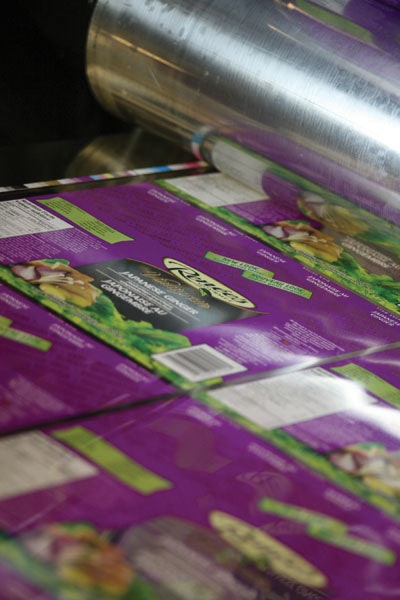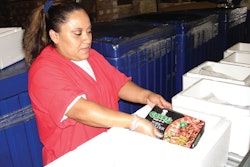Renee’s Gourmet, a brand of H.J. Heinz Canada Ltd., St Mary’s, Ontario,
Canada, is a leading Canadian manufacturer of refrigerated salad
dressings, focusing on formulations with no preservatives or MSG. For
many years, the company had been using paper-labeled glass jars to
package its line of dressings. But in 2005, Renee’s decided to take
advantage of advanced flexographic printing technology that lends
itself to vibrant, attention-getting printing and graphics on
360-degree shrink sleeve film labels.
The new label development project began in February 2005 and ended 18
months later. The newly labeled dressings entered the refrigerator case
in August 2006, just as H.J. Heinz Company of Canada acquired Renee’s
Gourmet.
Renee’s group marketing manager Joe D’Angelo notes, “We had been using
paper labels. But the fact that our dressings and dips sit in a chilled
environment means that moisture is a consideration. Paper, when wet,
tends to wrinkle and distort. It is a factor in the retail environment.
Shrink-sleeve film alleviates that moisture consideration. The
high-shrink rigid vinyl material we use now in our new packaging has a
powerful impact on the shelf. The chilled environment is not a large
factor any more.”
The PVC (polyvinyl chloride) high-shrink film used for the new labels
is a scuff-resistant structure called Pentalabel® OT-M148/01 developed
by Klöckner Pentaplast (www.kpfilms.com). Jones Packaging, Inc.
(www.jonespackaging.com) produces the eight-color (six colors plus two
hits of white) flexo-printed, 360-degree labels and specified the
Pentalabel film for the application based on the film’s consistency and
ability to deter graphics distortions. Once flexo-printed with
water-based inks, the labels are hot air-dried. Suppliers of the jars
and closures were not disclosed.
To print the labels, Renee’s chose Jones Packaging from among three
bidders—two of which were gravure printers. Jones presented the
benefits of flexographic printing, including relatively low pre-press
costs, quick turnaround, short-run flexibility, the ability to change
copy as necessary for multiple SKUs, and comparably vivid graphics. And
Renee’s was able to use their existing inventory of glass containers
with the new shrink sleeve labels so there was no container waste.
White ink is used as a background to simulate the look of paper labels.
Jones helped develop a modified water-based white background ink that
withstands heat and steam in the tunnel.
Packaging parameters
Renee’s Gourmet was very specific about the packaging criteria that
needed to be met. The logo had to be precisely positioned on the label.
The sleeve label needed to integrate a tamper-evident band that is
applied to the 355-mL contoured jar and folds over the lid. And the
band needed to include identification of the dressing flavor.
To address Renee’s directive that the flavor information appear on the
tamper-evident band, the machine installs a perforation into the film
on-line, rendering an easy-tear-open feature for consumers. The body of
the label stays firmly in place while the built-in tamper-evident band
pulls away from the twist-off lid.
Jones Packaging’s vp of process and product development Larry Patterson
notes, “Graphic distortion is always a factor with shrink sleeve films.
So with Renee’s, we printed black lines in a grid pattern. We used
those black lines for adjusting the artwork, and Renee’s graphics
agency fit their design to the grid. We then did a trial printing on
the sleeve and checked for placement. The process is computerized now.
But just two years ago, we hand-made the shrink sleeve label printed
with the black-lined grid.”
The printed label material is trimmed and then seamed or welded to turn
it into a tube. The tubed material is put on a rewind machine, and the
resulting roll is inspected for print registration accuracy.
To shrink the label onto the jar, Renee’s uses 100% steam in their
shrink tunnel. Renee’s bought new sleeve application equipment and a
heat shrink tunnel from Tripack (www.tripack.net) to accommodate the
new labels. The printed
tube-roll of labels is slipped over a sleeve applicator that is shaped
like a bullet to open the sleeves up. Each sleeve is automatically cut
and slipped onto the jar. The sleeved jar then is channeled into the
heat tunnel where the steam shrinks the label snugly to the jar
contours.
Speed to market
With more than 70% of Canadian sales in the refrigerated salad dressing
category, the line includes 12 varieties. All the label varieties are
color-coded.
Jones keeps pre-slit stock from Klöckner Pentaplast in stock at all
times for short runs, if Renee’s so requires for Just-In-Time
situations. If Jones wants to print on-demand to satisfy “surprise”
lead times, they have a ready supply of the clear vinyl film in their
warehouse. This supplier readiness gives Renee’s a speed-to-market
advantage.
D’Angelo says, “We believe the new labeling has helped continue the
brand’s growth. Klöckner Pentaplast’s film has done an effective job of
making the full-body label stand out. And Jones did a very good job for
us, and we developed a good partnership. They were diligent and
addressed issues head-on. We received a lot of support from them.”























